Upper arm muscles
Which upper arm muscles are there?
- Biceps (M. biceps brachii)
- Triceps (M. triceps brachii)
- M. brachialis
- M. anconeus

The upper arm muscles in detail with function
The upper arm muscles are in two groups divided, the M. biceps brachii and the M. brachialis are the muscles of the front group, of the M. triceps brachii and M. anconeus are those of the posterior group.The division is not only used for clarity, but also divides the muscles functionally.
The larger of the two front muscles is the Biceps muscle. Its name is derived from its shape and Translated from Latin into German means "two-headed arm muscle". It is therefore a muscle with two muscle bellies, one of which has its origin in the coracoid process, a bony protrusion of the shoulder blade, the second on the upper edge of the shoulder joint surface, also on the side of the shoulder blade. So it pulls from the shoulder blade, the scapula, over the humerus to the forearm and starts roughening the bones at the ulna and radius. So that's the Biceps muscle is a two-jointed muscle and performs functions in the Shoulder jointas well as in the elbow joint. He turns the arm inward and helps lift it sideways and forwards. In addition, it bends the elbow and helps with the outward rotation of the forearm (so-called supination). This is the turning movement of the forearm, as a result of which the palm of the hand points upwards.
The M. biceps brachii and the M. brachialis are supplied by the musculocutaneous nerve. This is part of the very big one Brachial plexus, the plexus of nerves that supplies the entire arm with motor and sensory nerves. Motor nerves control the movements of the muscles and sensory nerves transmit information of sensation and feeling, such as tingling or pain. The second muscle in the front group is the Brachialis muscle, which means something like "arm muscle". It starts at the humerus, the humerus, and ends at the ulna. He only pulls over one joint, the elbow joint. Its function is to bend the elbow. In addition to the musculocutaneous nerve, it is also supplied via the radial nerve. The radial nerve is also part of the brachial plexus.
Figure arm muscles

Arm muscles
- Two-headed upper arm muscle
(Biceps) short head -
M. biceps brachii, caput breve - Two-headed upper arm muscle
(Biceps) long head -
M. biceps brachii, caput longum - Upper arm muscle (arm flexor) -
Brachialis muscle - Three-headed upper arm muscle
(Triceps) side head -
M. triceps brachii, caput laterale - Three-headed upper arm muscle
(Triceps) long head -
M. triceps brachii, Caput longum - Three-headed upper arm muscle
(Triceps) inner head -
Triceps brachii muscle,
Caput mediale - Knobby Muscle - Muscle anconeus
- Elbow - Olecranon
- Upper arm spoke muscle -
Brachioradialis muscle - Long spoke-side hand straightener -
Muscle extensor carpi radialis longus - Spoke-sided hand flexor -
Muscle flexor carpi radialis - Superficial finger flexor -
Muscle flexor digitorum superficialis - Long palm tendon tensioner -
Palmaris longus muscle - Extensor tendon strap -
Retinaculum musculorum extensorum - Short spoke-side hand straightener -
Muscle extensor carpi radialis brevis - Elbow-sided hand flexor -
Muscle flexor carpi ulnaris - Finger extensor -
Muscle extensor digitorum - Trapezius -
Trapezius muscle - Deltoid -
Deltoid muscle - Pectoralis major -
Pectoralis major muscle
You can find an overview of all Dr-Gumpert images at: medical illustrations
The third muscle and first muscle of the rear muscle group is the Triceps brachii muscle. It is made up of three muscle tummies, hence its name. Similar to the biceps brachii muscle, it is a two-jointed muscle that performs functions in the shoulder and elbow joints. His first muscle belly, also called the long head, has its origin again on the shoulder blade, but this time on the back. The second, middle head, as well as the third, short head, are attached directly to the humerus. This means that only the first muscle belly, the M. triceps brachii caput longum, is involved in shoulder movements, while all three move the elbow joint. There the M. triceps brachii attaches as a unit to a protruding bone at the back of the ulna (the so-called olecranon). The olecranon can also be felt clearly through the skin by bending the arm. With the help of the triceps brachii muscle, the arm can be lifted backwards and pressed against the side of the body. He stretches his elbow.
Here, too, the supplying nerve is the radial nerve. The last upper arm muscle is the very small anconeus muscle (Musculus anconeus). It arises just above the elbow joint at the lower end of the humerus and, together with the triceps, attaches to the olecranon of the ulna. It is therefore an extensor of the elbow joint and is one-jointed. In addition, however, he has the task of tensioning the joint capsule and thus enabling movements without resistance. It is supplied by the radial nerve. Arterially, all muscles of the upper arm are supplied from branches of the subclavian artery, which merges into the axillary artery at armpit level, into the brachial artery at the level of the upper arm and finally into the radial and ulnar arteries. It is one and the same artery that repeatedly gives off small side branches as it runs along the arm, making it smaller in size. Every time it has passed a prominent anatomical point in its course, its name is changed. The venous blood that comes from the muscles is transported back to the heart via the arm veins.
Is it dangerous if one of the upper arm muscles twitches?
First of all, it should be clarified what exactly it means when a muscle twitches. In order for muscles to tense up and move our body as a result, they have to receive an electrical signal from a nerve. However, a nerve fiber does not control the entire muscle, but only some muscle fibers, i.e. only small sub-units of the muscle. Such a nerve fiber is referred to together with "its" muscle fibers as a motor unit. If only such a motor unit, but not the entire muscle, is electrically stimulated, the fibers twitch, but cannot perform any directed, meaningful movement. We can then feel this twitching. If one of the upper arm muscles twitches, only part of the muscle is activated, while the rest remains relaxed. This means that it is not dangerous if an upper arm muscle twitches, because it is a completely normal event that takes place in the body. Such twitching can often occur after tension, for example after doing sports and using our arms a lot. Individual nerve fibers have not yet noticed, so to speak, that the training is actually over and continue to fire electrical signals. As long as the twitching doesn't become painful, spreading, or "tingling", there is nothing to worry about.
Read more about this in the sections on muscle cramps and, especially if you have a tingling sensation, under brachial plexus paralysis.
However, the muscle twitching can be dangerous if it lasts longer and occurs without a reason, i.e. without prior stress, you should consult a doctor. Then actual damage to the nerve or the coupling between nerve and muscle may be present.
Upper arm muscles are hardened
Is it bad if the upper arm muscles are hardened? Most likely not. Hardened means that the muscle is clearly hard and unyielding through the skin. Such a hardening can affect the entire muscle or only individual areas. The cause is usually a sticking of the muscles with the overlying fascia, i.e. the connective tissue that surrounds the muscles like skin. Such bonds usually come off on their own. However, if they last longer, they can be treated with warmth and movement. You should never hold the muscle still and don't move, because that leads to even more hardening.
Upper arm muscles hurt
Exerting too much and too much effort can overuse our muscles. This causes them to become tense and painful. This often occurs with muscles that do mainly “holding work”, ie those muscles that are constantly tense to keep us upright and straight. These are mainly the back, neck and shoulder muscles. Pain once the upper arm muscles, which is quite unusual. The cause of pain in the upper arm muscles is usually an overload when training the muscles and not a bad posture. While too much exercise is advised for back pain, upper arm muscle pain should be treated with warmth and light movements. The muscles should therefore continue to be used, but not with a lot of weight. You should also avoid lifting heavy bags. The pain usually arises in that we have performed a wrong short and strong movement, whereby Muscle fibers pulled were. These then have to slowly repair themselves. We can only offer you moderate support and should definitely avoid additional injuries. However, if the pain radiates into the shoulder, feels burning and tingling, or if parts of the arm even feel numb, you should see a doctorto rule out possible injury to the nerves.
Exercise the upper arm muscles
There are different types of training. Examples are: fitness training, strength training, bodybuilding or anaerobic training.
In general, the best way to train muscles is to imitate and repeat their natural movements. This means that you look at what their normal function is and then train that movement. You can do this either by your own body weight or with the help of heavy objects like dumbbells. If you want to train the biceps brachii muscle, it is best to do this with dumbbells and not with your own weight.
Since the biceps is the strongest supinator, i.e. the rotator of the wrist, this movement should be included in the training. The elbow should be held against the torso. You bend the relaxed arm hanging down in the elbow and turn the palm upwards while bending. If you stretch your arm out again, it should not be relaxed as far as it will go. There should always be a certain basic tension in the arm. The number of repetitions of this movement depends on the weight, but it should be about 15-20 times. You then do a set of movements like this about two or three times.
If you train the biceps brachii, you always train the brachialis too. The triceps brachii muscle can be trained well with body weight. Any movement that involves actively extending the elbow joint involves the triceps. That would be, for example, push-ups or arm movements when swimming breaststroke. Of course, you can also train your triceps with dumbbells. To do this, raise your arm back and up in a straight position. This also trains the muscle attachments on the shoulder. Again, the movement should be repeated 15-20 times. Once 20 repetitions represent one set. 2-3 of these sets should be completed. Ideally, there should be 48 hours, i.e. two days, between such training units, consisting of two to three sets. During this time, the muscle has regenerated, so recovered and can be fully loaded again. If the time between the units is too short, this can quickly lead to muscle injuries, especially for beginners. On the other hand, if it is too long, the muscle building effect is significantly less.
Further information on the subject of upper arm muscles can be found here:
Other topics that might interest you:
- Joints
- Back upper arm pain
- Upper arm pain in front
- Left arm pain
- Right arm pain
- Forearm pain
- Back pain
- Torn hamstring
- Pain in the right upper arm






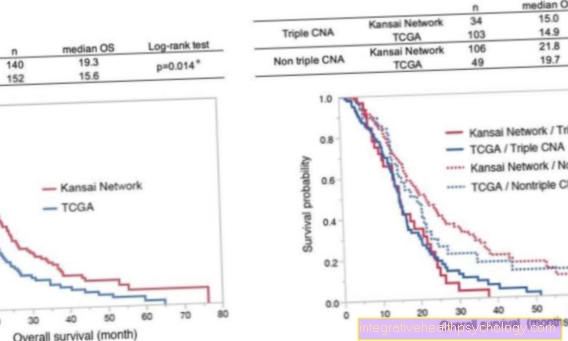


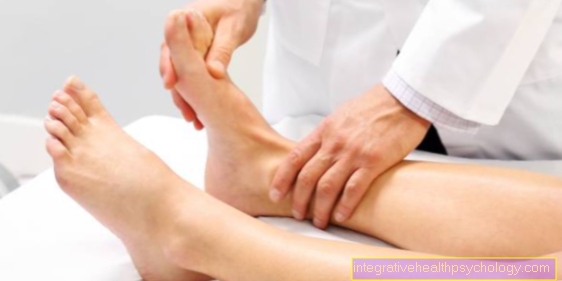

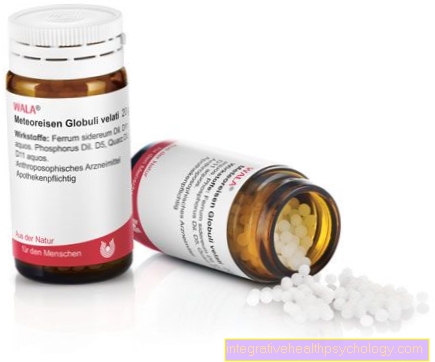



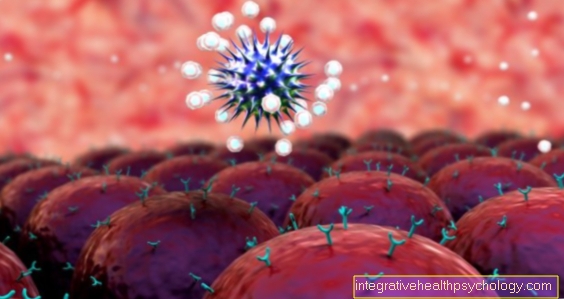
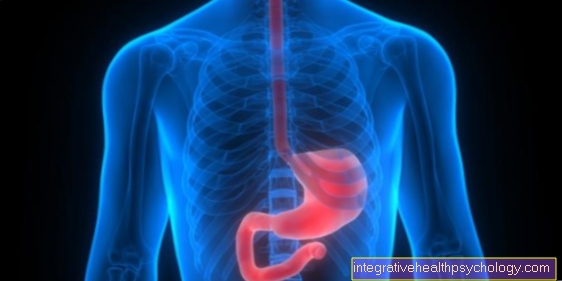







.jpg)




